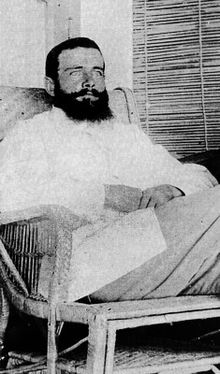Ludwig Külz
Ludwig Külz (born February 18, 1875 in Borna , † 1938 in Erdmannshain ) was a German colonial doctor , tropical medicine and Africa researcher.
Life
Külz was born the son of a pastor and was the twin brother of the liberal politician and Reich Interior Minister Wilhelm Külz . In contrast to his twin brother who turned to law, Ludwig studied medicine. After graduation with the doctorate to Dr. med. in 1899 he did his military service as a naval doctor in the Imperial Navy and took part in a five-month trip abroad to southern Africa. In 1902 he became a government doctor in the German colony of Togo and in Cameroon until 1912. As such, he was professionally involved in the task of using medical arguments such as malaria prevention to achieve the politically desired segregation in the German coloniesbetween black and white as hygienically necessary. These arguments were supporting in the Douala - expropriation , the 1914 in the execution of Chief Rudolf Manga Bell culminated.
He was deputy head of the medical-demographic German New Guinea expedition of 1913/14 of the Reich Colonial Office , in which the tropical medicine professor Alfred Leber took part as leader of the expedition, as did the painter Emil Nolde and his wife. This expedition ended just before the start of the First World War .
In December 1914 he managed to escape from Hollandia to Germany on a Dutch cargo ship under incognito. In July 1915 he was promoted to the medical council. First he was deployed in military hospital 18 near Sedan , then he was regimental doctor in the field artillery regiment 7. After his promotion to senior naval doctor in 1916, he was seconded to the staff of Field Marshal Colmar von der Goltz in Turkey and later on in Romania.
His memories of the time in Africa found a wide readership again after his death in the Third Reich.
Works
- Literature by and about Ludwig Külz in the catalog of the German National Library
- On the question of women in the German colonies . In: Koloniale Monatsblätter , Vol. 15, 1913, pp. 61–67.
- Tropical doctor in the African bush. 3. Edition. Berlin 1942.
literature
- Ludwig Külz: Sheets and letters from a doctor from tropical German Africa. Verlag Wilhelm Süsserott, Berlin 1910.
- Ada Nolde: Some memories. a planned lecture about the joint trip to the South Seas. In: Emil Nolde - Die Südseereise 1913–1914. Pp. 43-71.
- Manfred Reuther (Ed.): Emil Nolde - Die Südseereise 1913–1914. German-English catalog for the exhibition in Berlin. DuMont , Cologne 2008, ISBN 978-3-8321-9083-5 .
- Manfred Reuther: Emil Nolde's East Asia trip and the eventful South Sea trip. In: Emil Nolde - Die Südseereise 1913–1914. DuMont, Cologne 2008, ISBN 978-3-8321-9083-5 , pp. 21-27.
- Ralph Erbar: A "place in the sun?" - The administrative and economic history of the German colony Togo 1884–1914. (= Contributions to colonial and overseas history. Volume 51). Stuttgart 1991, ISBN 3-515-05800-1 .
- Johannes W. Grüntzig , Heinz Mehlhorn: Alfred Th. Leber (1881–1954): A pioneer of tropical ophthalmology - lost in the South Seas - rediscovered in India. In: Clinical monthly sheets for ophthalmology. 201 (4), Oct 1992, pp. 254-262.
- Johannes W. Grüntzig, Heinz Mehlhorn: Expeditions into the realm of epidemics. Medical ascension orders of the German imperial and colonial times. Elsevier-Verlag, Munich 2005, ISBN 3-8274-1622-1 .
Web links
supporting documents
- ^ Andreas Eckert: Property, Land Conflicts and Colonial Change - Douala 1880 to 1960 . Franz Steiner Verlag, Stuttgart 1999, p. 118.
- ↑ Wolfgang U. Eckart : Political "seizure of power" and medical science: The law for the prevention of hereditary offspring of July 14, 1933. In: Christoph Gradmann , Oliver von Mengersen: The end of the Weimar Republic and the National Socialist seizure of power, lectures Heidelberg historians in the President Friedrich Ebert Memorial . Manutius Verlag, Heidelberg 1994, ISBN 3-925678-48-4 , pp. 155-156. (To Ludwig Külz, who confronted the "bastardization" problem with children born into marriages between white settlers and colored natives)
- ↑ Biographical Handbook German New Guinea. 2nd Edition. Fassberg 2002, OCLC 79203975 , p. 212.
| personal data | |
|---|---|
| SURNAME | Külz, Ludwig |
| BRIEF DESCRIPTION | German colonial doctor, tropical medicine and Africa researcher |
| DATE OF BIRTH | February 18, 1875 |
| PLACE OF BIRTH | Borna |
| DATE OF DEATH | 1938 |
| Place of death | Erdmannshain |

